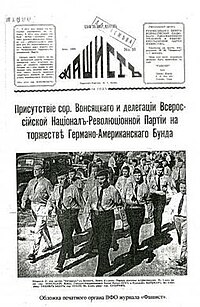Fashist
 Cover of Fashist, 1939 | |
| Type | Monthly |
|---|---|
| Format | Broadsheet |
| Publisher | Anastasy Vonsyatsky |
| Editor | Donat Yosefovich Kunle |
| Founded | August 1933 |
| Political alignment | Fascist |
| Language | Russian language |
| Ceased publication | July 1941 |
| Headquarters | Putnam, Connecticut, United States |
| Circulation | ~10,000 |
Fashist (Russian: Фашистъ, 'Fascist') was a Russian fascist publication, issued from Putnam, Connecticut, United States.[1] It was published by Anastasy Vonsyatsky.[2] Fashist was distributed among Russian exiles around the world.[3]
Launching[]
The first issue of Fashist was published in August 1933.[3] The first issue was printed in 2,000 copies.[2] Donat Yosefovich Kunle was the editor of Fashist.[1][4] The publication functioned as an organ of the All-Russian Fascist Organization.[5]
Profile[]
Fashist was published more or less on a monthly basis. Each issue was printed in roughly 10,000 copies.[2] The publication had a newspaper format, but was printed on costly glossy paper. The material of the publication consisted of reports on party activities as well as historical narratives. Fashist dedicated a lot of attention to Civil War nostalgia, praising the role of the White Army and its leaders.[2]
Fashkors[]
Many authors of articles in Fashist were kept anonymous, to avoid reprisals from Soviet agents. Instead, they signed the articles as fashkor (фашкор, short for 'Fascist Correspondent', compare with rabkor) followed by their party membership number and geographic location.[2] By using the pseudonyms of many different fashkors, Fashist created the impression of being in the epicentre of a vast global network of émigré Russian fascist agents as well as a network of saboteurs with the Soviet Union.[2][6] In reality, Vonsyatsky could count on only a handful of Russian exiles as correspondents.[6]
Later period[]
As of 1938–39, it served as the organ of the All-Russian National Revolutionary Workers-Peasants Party of Fascists.[1] Fashist ceased publication in July 1941.[7]
References[]
- ^ a b c Russian Periodicals in the Helsinki University Library, A Checklist, Library of Congress, 1959, p. 16.
- ^ a b c d e f Stephan, John J. The Russian Fascists: Tragedy and Farce in Exile, 1925–1945. New York: Harper & Row, 1978. pp. 124–25
- ^ a b Laqueur, Walter, George L. Mosse, and Gilbert Allardyce. International Fascism, 1920–1945. New York: Harper & Row, 1966. p. 163.
- ^ Stephan, John J. The Russian Fascists: Tragedy and Farce in Exile, 1925–1945. New York: Harper & Row, 1978. p. 212
- ^ Winter, Barbara. The Most Dangerous Man in Australia. Carindale, Qld: IP (Interactive Publications), 2010. p. 131
- ^ a b Hassel, James E (1991), "Exile Community Organisation & Services", Transactions of the American Philosophical Society: Russian refugees in France and the United States Between the World Wars, Philadelphia: American Philosophical Society, pp. 64–65, ISBN 9780871698179.
- ^ Фашист (Putnam, Connecticut, USA, 1933–1941), RU: Emigrantica, archived from the original on 16 April 2013.
- 1933 establishments in Connecticut
- Monthly magazines published in the United States
- Defunct political magazines published in the United States
- Fascist newspapers and magazines
- Magazines established in 1933
- Magazines disestablished in 1941
- Magazines published in Connecticut
- Putnam, Connecticut
- Russian fascism
- Russian Fascist Party
- Russian-language magazines
- White Russian emigration
